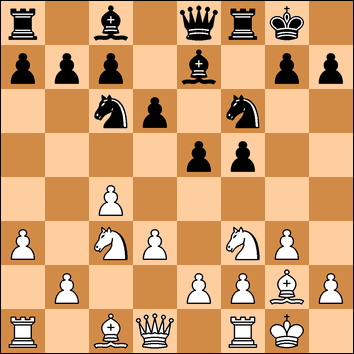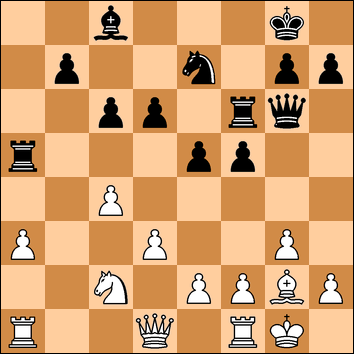Swale Club Chess Championship - Round Twelve
Thursday 28 February 2019
White: Rufus Edwards (ungraded) Black: Keith Nevols (163)
English Opening
1. c4 e5
My favourite system against the English is playing this aggressive set up, which is similar to a Dutch but with e5 already played.
2. Nc3 d6
3. g3 f5
4. d3 Nf6
5. Bg2 Nc6
6. a3 Be7
I had considered 6. ... a5 but was concerned over 7. Qb3 and whether that would hold up my development, so wanted to get the king castled as soon as possible.
7. Nf3 O-O
8. O-O Qe8
Acting as if this were a Dutch defence. The queen moves to the kingside to commence the attack. There are significant differences - Black already has a pawn on e5 and a knight on c6. However White has potential for an attack on the queenside.

Here White can consider Bb2, b4, or perhaps moves like Rb1. Instead he redeploys the kings knight, which suits me as it moves away from the defence of the White king.
9. Ne1? a5
Taking time out to hold up the queenside play which I mentioned but this precaution might not have been necessary. 9. .. Qh5 or 9. .. f4 10. gxf4 Qh5 are both moves to take the initiative.
10. Nc2 Qg6
At the moment, a White b4 is not possible so time to improve the queen's position.
11. Nd5 Bd8
12. Bd2 Ne7
12. ... f4 is an aggressive idea. If 13. gxf4 then Nxd5 14. cxd5 Nd4 15. Ne1 exf4 with a strong initiative, so White might play 13. Kh1 which could be met with 13. ... Ne7.
But I decide to just eject the knight, and solidify the diagonal.
13. Nxf6 Rxf6
Preferable to 13. .. Qxf6 as I wanted to keep the queen where it was.
14. b4 c6?!
For the last few moves, the engines have been recommending a White f4 to add some solidness to the white defence. Here it thinks that 15. f4 means that White will be better. After 15. ... axb4 16. axb4 Rxa1 17. Qxa1 Bb6+ 18. Kh1 it does not look easy to find a way for Black to break through.
15. bxa5?!
This, however, not only leaves a weak isolated pawn on a3, which could be useful for me in an ending, but also allows me to overload his bishop and get f4 in.
15. ...... Bxa5?
15. .. f4 straight away is stronger.
16. Bxa5 Rxa5

17. Nb4?
Missing White's last chance to play f4. After 17. f4 exf4 White has 18. Qd2! Ra8 19. Qxf4 and Black is beginning to look a bit shaky.
17. ..... f4
At last!
18. Qb3
18. Qd2 is an interesting defence.
18. ...... Kh8
I could have played 18. .. Be6, 18. .. Bg4 or 18. .. Qh5, as the discovered check is not a threat, but. learning from recent hiccups, I wanted to avoid any accidents.
19. Be4
This gives me the chance to remove White's key defender in front of the king.
19. .... Bf5
20. Bxf5 Qxf5
21. Rae1 Qd7?
An unnecessary retreat. 21. .. Qh3 or 21. . Rh6 wins at once. But I was seeking to redeploy the pieces to bring up another attack. White could play 22. Kh1 and Rg1 to hang around for a while.
An unnecessary retreat. 21. .. Qh3 or 21. . Rh6 wins at once. But I was seeking to redeploy the pieces to bring up another attack. White could play 22. Kh1 and Rg1 to hang around for a while.
22. Qc3 Ra8
22. .. Qh3 is mate in eight (!) so I am told.
22. .. Qh3 is mate in eight (!) so I am told.
23. Nc2 Raf8
24. d4 e4?
24. .. Qh3 still wins at once.
25. Rd1
At last, I spot the move I had been overlooking all this time.
25. ...... Qh3

There is no decent defence to a Black Rh6 and so here White resigned. A nice win which I made slightly heavy weather of.